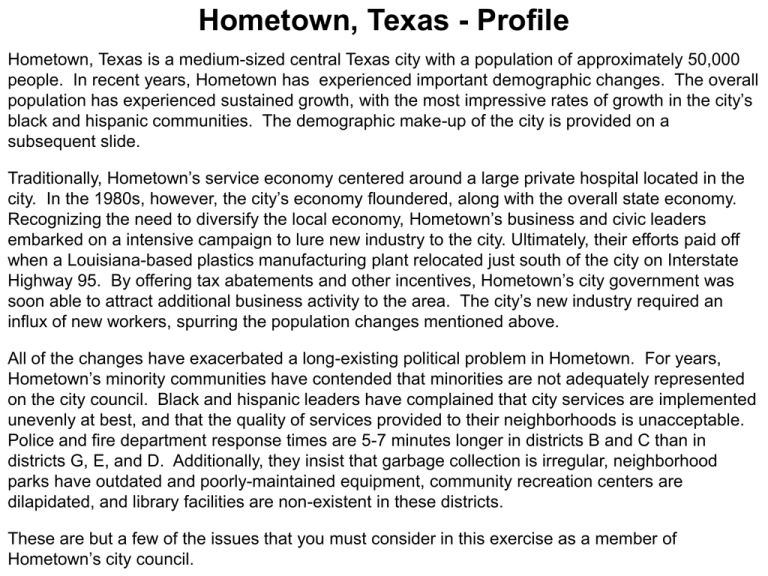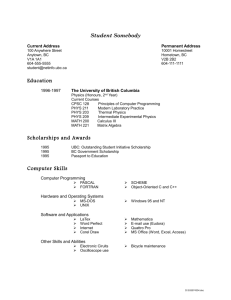Hometown, Texas - Profile
advertisement

Hometown, Texas - Profile Hometown, Texas is a medium-sized central Texas city with a population of approximately 50,000 people. In recent years, Hometown has experienced important demographic changes. The overall population has experienced sustained growth, with the most impressive rates of growth in the city’s black and hispanic communities. The demographic make-up of the city is provided on a subsequent slide. Traditionally, Hometown’s service economy centered around a large private hospital located in the city. In the 1980s, however, the city’s economy floundered, along with the overall state economy. Recognizing the need to diversify the local economy, Hometown’s business and civic leaders embarked on a intensive campaign to lure new industry to the city. Ultimately, their efforts paid off when a Louisiana-based plastics manufacturing plant relocated just south of the city on Interstate Highway 95. By offering tax abatements and other incentives, Hometown’s city government was soon able to attract additional business activity to the area. The city’s new industry required an influx of new workers, spurring the population changes mentioned above. All of the changes have exacerbated a long-existing political problem in Hometown. For years, Hometown’s minority communities have contended that minorities are not adequately represented on the city council. Black and hispanic leaders have complained that city services are implemented unevenly at best, and that the quality of services provided to their neighborhoods is unacceptable. Police and fire department response times are 5-7 minutes longer in districts B and C than in districts G, E, and D. Additionally, they insist that garbage collection is irregular, neighborhood parks have outdated and poorly-maintained equipment, community recreation centers are dilapidated, and library facilities are non-existent in these districts. These are but a few of the issues that you must consider in this exercise as a member of Hometown’s city council. City of Hometown, Texas Wards and Representational Demographics ETJ HUD Development 70% Black/Hispanic G IH - 95 30% White 100% White [7,150] 40% White [2,860] FS #2 30% Black [2,145] B Hospital 25% Hispanic [1,785] 5% Asian [360] 57% White [4,075] 43% Black [3,075] E 96% White [6,850] F A C 56% Black [4,000] 50% Hispanic [3,575] FS #3 FS #1 44% Hispanic [3,150] 45% Black [3,220] 5% Asian [355] 3% Asian [300] D 91% White [6,500] 9% Asian [650] Plastics Plant proposed Hometown’s Demographics W ARD No. W hites Blacks Hispanics A B C D E F G 0 2,860 0 6,500 6,850 4,075 7,150 4,000 2,145 3,220 0 0 3,075 0 3,150 1,785 3,575 0 0 0 0 0 360 355 650 300 0 0 Totals 27435 12440 8510 1665 Total Polulation = 50,050 W hite = 27,435 or 55% Black = 12,440 or 25% Hispanic = 8,510 or 17% Asian/Other = 1,665 or 3% Asian/Others Totals 7150 7150 7150 7150 7150 7150 7150 50050 City of Hometown, Texas City Departments • • • • • • • • • • Police Fire Sanitation Public Works Parks and Recreation Public Health Library Finance, Budgeting, and Accounting Transportation Tourism and Historic Preservation City of Hometown, Texas FY 2000 Budget The city’s Budget Office projects that the city will receive approximately $2.5 million in additional revenues this fiscal year. The new revenues will come from a variety of sources, primarily increased sales tax revenues generated by the city’s robust economy and increased property tax revenues resulting from higher property valuations. Having become aware of the anticipated windfall, city department heads have formulated their decision packages for FY 2000. A decision package is essentially a department head’s “wish list”; each department chair wants to get his or her piece of the $2.5 million pie. The city council must decide how to spend this $2.5 million windfall. However, it cannot reduce the departments’ existing operating budgets to pay for any of the decision packages. If any of the budget requests are approved by the council, they must be paid for out of the projected $2.5 million. Taxpayers in the city are absolutely opposed to any tax increase. Budget Requests for FY 2000 Department Description Budget Request Police Police Police Fire Fire Fire Sanitation Sanitation Public Works Public Works [Code Enforcement] Parks and Recreation Parks and Recreation Public Health Public Health Public Health Library Library Finance, Budgeting, and Accounting Transportation Tourism and Historic Preservation *** *** *** *** *** New Communications System 5 New Patrol Cars New Uniforms New Fire Station 85 ft. Platform Truck Emergency Medical Vehicle 4 New Packers Street Sweeper New Street Paving Equipment New Inspector Position New Park and Athletic Facilities Gynasium Renovation New Resturaunt Inspector New Animal Control Officer Childhood Immunization Program New Library Internet Capabilities New Computer Downtown Parking Garage Statue of Town Founder 2.5% Pay Raise - All City Employees Salary/Benefit Study Expansion of City Services to ETJ Establishment of Citizen Review Board Action Center $350,000 125,000 38,080 1,500,000 350,000 72,100 420,000 100,000 56,000 78,000 1,350,000 56,000 70,000 70,000 200,000 $770,000 25,000 202,160 1,470,000 100,000 250,000 $60,000 1,500,000 $50,000 $65,000 Total of All Requests = $9,327,340 City of Hometown, Texas Budget Requests for FY 1999 POLICE DEPT. -- New Communications System Estimated Cost: $350,000 [installed]; the City can get a federal reimbursement grant for 30% of this cost The present police radio system is 18 years old, and the police chief says a new one is needed. The new system would consist of a communications console for police headquarters, a repeat transmitter on the highest building in town, and 10 portable units to be used by officers while on patrol. The console and transmitter would cost $300,000 and the portable units would cost $50,000. The portable units can be plugged into patrol cars and serve as car radios, which would save the city the cost of regular radios at $3,500 each. Similar systems are currently being used in several neighboring cities. The manufacturer says that the system can be installed and operating six to nine months after the order is placed. The police chief argues that that the new communications system could help shave 2-3 minutes off response times citywide. POLICE DEPT. -- New Patrol Vehicles Estimated Cost: $125,000 [for five vehicles]. The Hometown police department currently has ten patrol vehicles, half of which are replaced each year. In their first year, new cars are run 50,000 miles as patrol vehicles. In the second year, two serve as back-up patrol vehicles, two are transferred to the investigation unit, and one is assigned to the shift captain. The vehicles generally have 70,000 to 80,000 miles at the end of the second year at which time they are sold at auction. The police chief is requesting five full-sized sedans with V-8, 350 cubic inch engines at $25,000 each. The police chief argues that the existing fleet of intermediate-sized cars do not provide enough trunk space for equipment or enough passenger space to transport suspects and prisoners safely. The costs of $125,000 does NOT include roll bars, search lights, sirens, radios, or other specialized police equipment. POLICE DEPT. -- New Uniforms Estimated Cost: $38,080 In an effort to improve the City’s image, the Hometown Chamber of Commerce has recommended that municipal police officers be outfitted with new, spiffier uniforms. The president of the Chamber says the present uniforms are drab and uninspiring and that, since police officers project an image of the City, new uniforms will help to promote the city as an attractive place to live and work. Additionally, a recent, nationally-covered incident involving the beating death of a homeless man by three of Hometown’s officers has cast a shadow on the Police Department’s and the City’s image. The president of the Chamber believes that, while new uniforms cannot erase the incident, they can serve as a symbol of a modernized police force. A three-person committee composed of one representative from the Chamber, the Hometown Fashion Guild, and the Police Department reviewed various uniform styles and recommended one to the Police Chief. The chief likes the choice, as do all of the officers, so the request for new uniforms was included in this year’s budget. To encourage the Council to approve the new uniforms, the Chamber of Commerce has agreed to pay $15,000 of the total cost. FIRE DEPT. -- New Fire Station Estimated Cost: $1,500,000. Hometown currently has two fire stations - one is located on the west side of district A near the boundary of district F; the other is located in the center of district G. The Fire Chief claims that response times to districts B and C, and the eastern parts of district D could be cut in half by building a new station on a city-owned lot located on the boundary of districts C and B. Plans call for a station large enough to accommodate a pumper truck, a ladder truck, an ambulance, two smaller vehicles, living quarters, a classroom, a communications center, two administrative offices, and outside parking. FIRE DEPT. -- 85 ft. Platform Truck Estimated Cost: $350,000. The two existing fire stations now have between them two 2,000-gallon tanker trucks, two 1,000-gallon-per-minute pumper trucks, one 1,250 gpm pumper, and one chief’s vehicle. Neither has a ladder or elevated platform truck. The fire chief believes that the department is poorly equipped to respond to fires in the the city’s rapidly growing industrial park. New businesses are constructing multi-level office buildings and plants. The State Fire Rating Bureau recommends that Hometown acquire an elevated platform truck before the new 6-story apartment building to be constructed in the downtown area opens in 2002. If the city does not acquire a new patform truck before construction is completed, its fire rating will drop, costing property owners an additional 10% in fire insurance premiums. The chief argues that a recent fire on the top floor of the city’s tallest downtown building illustrates the potential for disaster. Although the fire was small and contained, the department had to call for the assistance of a neighboring city’s fire department that does have a platform truck. Local business leaders have endorsed the chief’s proposal. FIRE DEPT. -- Emergency Medical Vehicle (Ambulance) Estimated Cost: $72,100. This estimate includes costs for the vehicle, a radio system, and diagnostic and treatment equipment. Hometown’s senior citizens’ council has been petitioning the city for several years to establish emergency medical service. The county has an emergency medical service that operates from the county seat, Far Away, located at the other end of the county, but the distance, response times, and service to Hometown have been inadequate. Several deaths have occurred that doctors say could have been avoided if medical services had been on the scene sooner. The fire chief says that if an EMS service is assigned to his department, he will need new personnel (six positions at $28,000 annual salary) to operate the service. Salaries and benefits for new personnel are NOT included in this decision package. SANITATION DEPT. -- 4 New Packers Estimated Cost: $420,000. The Sanitation Department has six compacting (garbage collection) trucks. Two are over six years old; two are 4-6 years old, and the remaining two are less than 4 years old. The Sanitation Director wants to replace the oldest two packers, as well as expand the total fleet to 8 vehicles. The usual life of a packer is 5 years, and the director says that, if not replaced, the engines of the oldest two packers will have to be rebuilt for a total of $50,000. With these repairs, the trucks will probably last for another 2 years. Expanding the fleet will allow the Sanitation Department to provide a higher level of service to parts of the city that have, up until now, experienced uneven service. The director maintains that the deteriorating condition of the fleet will result in poorer service to all areas of the city. SANITATION DEPT. -- Street Sweeper Estimated Cost: $100,000. Three years ago, Hometown entered into an agreement in principle with other city governments in the area to reduce storm water runoff pollution. This problem occurs when a substantial rainfalls gathers oil deposits, antifreeze and coolant residues, rubber from tires and car hoses and other solids, battery acids, pesticides, herbicides, and fertilizers, etc. that have collected on city streets and sluices them into storm sewers which transport the pollutants into area rivers, lakes, and reservoirs. One effective way of reducing the runoff problem is a regular program of street sweeping. The Sanitation Department currently has no automated street sweeping equipment. The Sanitation Director reminds the city council that it has committed to addressing the problem and warns that if the city does not take action soon, it could be cited for failure to comply with federal regulatory standards and penalized by the Environmental Protection Agency. PUBLIC WORKS DEPT. -- Street Paving Equipment Estimated Cost: $56,000. Hometown has 55 miles of city-maintained streets. Three years ago, 15 miles of residential streets, primarily on the east side of town, were unpaved and lacked curbs and storm sewers. The city council decided , at that time, to pave and put in curbs and storm sewers. The city contracted with a private construction firm to complete the project at an estimated cost of $2.5 million. Thus far, the project has progressed on schedule and has received strong support from property owners along the streets to be paved. However, a minority of property owners on the streets to be paved next year object to the project because, under the plan, curb and storm sewer costs are being assessed to abutting property. The new Public Works Director says the paving should not be done without the curbs and gutters because it would require greater maintenance and not last as long. The mayor has entered the fracas, expressing doubt that the city can continue with such an expensive project. He says that 30% of the paving, curb, and gutter costs should be assessed to property owners. To complicate the picture, the Public Works Director argues that, if the city would purchase a new paving machine at $56,000, his crews could do the work at 60% of the original estimate, with curb and gutters to be contracted out. Needless to say, private contractors have strongly objected to this plan.

